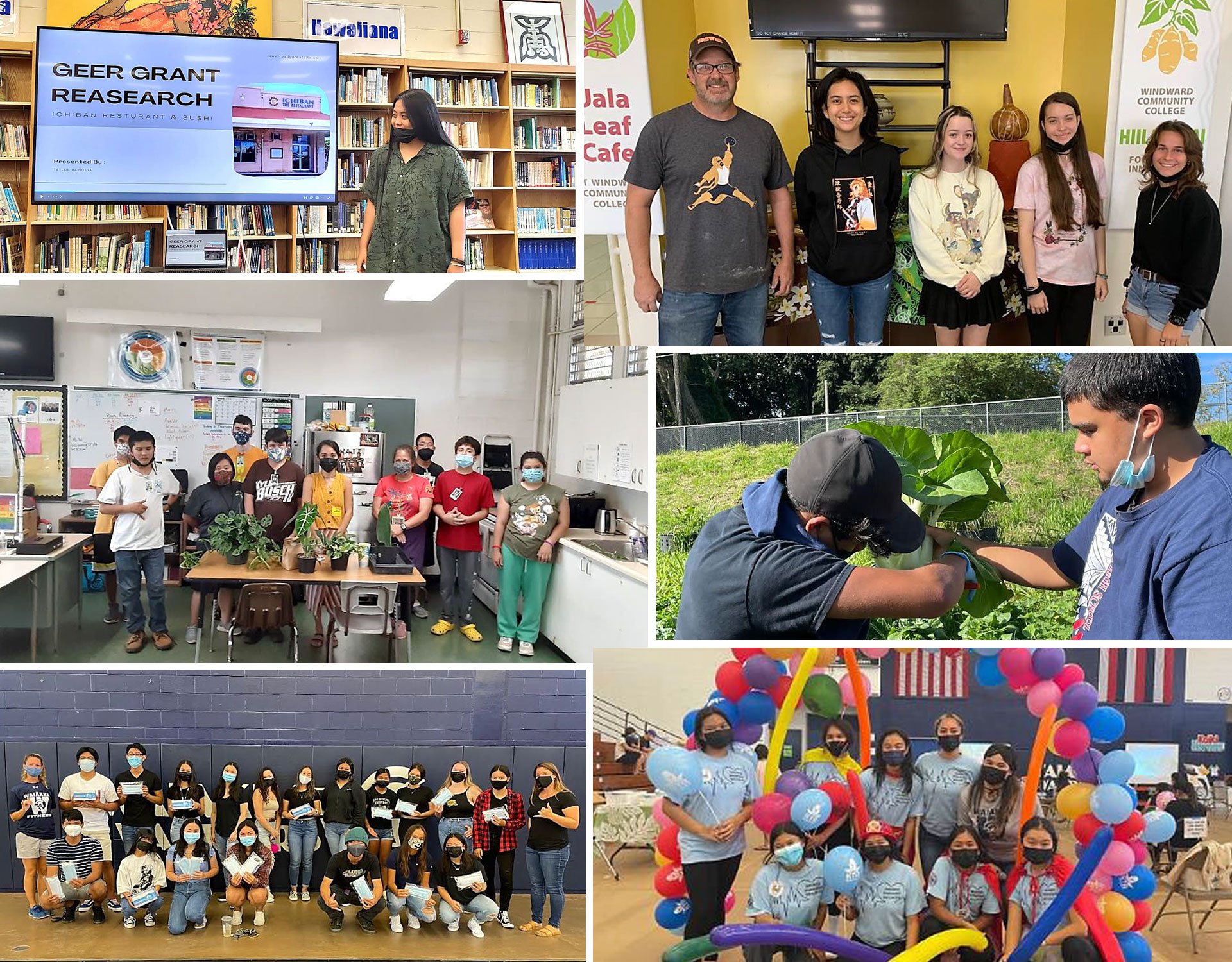Hawai‘i Academies Consortium of Schools
Community Building and Engagement Using Project Based Learning or Design Thinking
SUMMARY
Our Hawai‘i Academies Consortium is a group of 25 public high schools who are working together in communities throughout the state on the islands of Hawai‘i (7 high schools), Kauai (3), Maui (1), Molokai (1) and Oahu (13) who are structuring their schools using the academy model. The schools’ demographics vary from large to small, urban to rural, and national model academies schools just beginning their journeys. The goal of the project was to have each of our schools partner with a small business or a non-profit in its community that was adversely affected by the Covid-19 pandemic and to devise and implement a plan that would help the partner overcome some of its losses while giving our students real-life lessons using Project-Based Learning or Design Thinking strategies. While developing outreach skills, students would be able to earn Early College credits and teachers would be able earn PDE3 credits for advancement.
PROJECT LEAD : Edison Chong
CONTACT :
edison.chong@k12.hi.us
(808) 358-9240
OUTCOME :
Goal #1: Each Hawai‘i Academies High School will work on a plan to help a community partner overcome some of the difficulties with Covid-19. Each school has completed a project the past school year and/or is continuing a project with a small business or non-profit in its community. Some of our schools have engaged in/completed multiple projects.
Some of our projects were:
Honoka'a High and Intermediate School continued a tradition of providing a meal (grab-n-go because of Covid) on the Wednesday before Thanksgiving to any community member. In addition, four hundred meals were delivered to the homebound elderly.
Kea'au High School students grew produce that they supplied to an overwhelmed community store that had increased business because residents did not want to travel further to the larger stores because of Covid.
James B. Castle High School art students created designs that were transferred onto cookies that they sold, with the profits being donated to a Windward Community College program that assisted low-income students in obtaining meals.
Goal #2: Provide four Early College opportunities for students from all our schools to develop skills to help them with their community projects while earning college-level credits. We surpassed our goal by offering six ICS 101: Digital Tools for the Information World classes. Kapiolani Community College (CC), Kauai CC, Maui College, and Windward CC provided the instructors and handled the logistics for this innovative effort. For example, in one of the cohorts, students from Kapa'a and Waimea High Schools on Kauai were enrolled with students from Honoka'a and Kea'au High Schools on the Big Island in a course taught by an instructor at Kauai CC. As a bonus, we could offer a Design Thinking Boot Camp for teams at five of our schools.
Goal#3: Offer opportunities for our teachers/staff to earn college-level credits while developing skills in Design Thinking. One PDE3 Design Thinking in-person class for our teachers/staff during the summer 2022 with virtual follow-up lessons was offered. Logistical and administrative issues limited us to only one opportunity instead of our plan for two.
LESSONS LEARNED :
First, we learned that you need to take what is given and adapt. The timelines of the grant were challenging for the grant administration and for our individual schools. Offering six Early College Classes was ambitious. Without the help of partners who volunteered their expertise and worked through much of the logistics for us, the Early College courses would never have happened. Finding instructors and Community College partners took extra efforts. The limited time we had to recruit students for enrollment was too short and there were empty sears. This arrangement was new ground for all involved.
Secondly, we need time and space to develop our relationships. Each of our partnering schools is in different phases of implementation of its goal of developing academies. Eight new schools joined the consortium. Virtual meetings have limitations; school leaders do not have the opportunities to meet, develop relationships, and collaborate face-to-face. There were communication issues resulting in that some schools were not as productive as others. Many of our schools embraced the goals of the project right away, but some of our schools, especially our new schools, took additional time to get started. Our consortium’s strength is that we embraced a collegial atmosphere where schools can learn from the experiences and journeys of others.
Thirdly, it was important that our schools accept rapid communicating and decision-making. Although we wanted to be as collaborative as possible, circumstances frequently dictated top-down decisions. Since each of the schools had its own project, communication of grant information was sometimes misinterpreted. We had a difficult time obtaining approval to offer credits for a PDE3 class. Final approval was received on the last day of the school year and many teachers had already checked out. At that point our communication channels were limited and there were missed opportunities.
Overall, we consider our grant implementation highly successful. We achieved mostly all our goals and we were able to provide additional activities. Fortunately, our Hawai‘i Academies partnerships will continue following the grant. Our schedule for the year provides many new opportunities for our schools to mentor and support each other.





